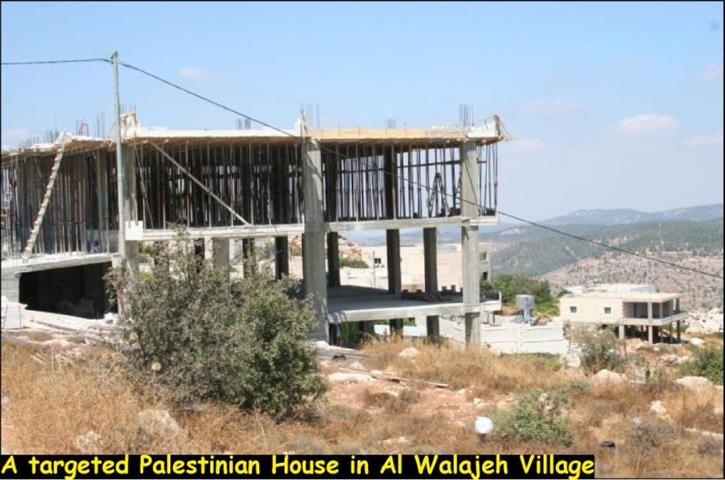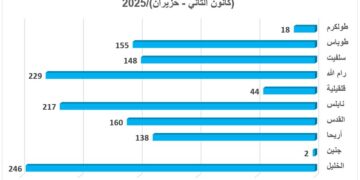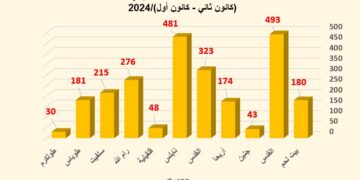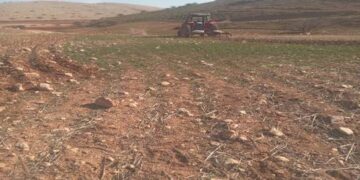Al-Walajeh Village is located 8.5 km southwest of Jerusalem city, and about 4 kilometers northwest of Bethlehem city. It has a population of 1968 (PCBS 2007) and is bordered by Battir and Husan villages from the southwest, by Sharafat village and Gilo settlement (established in 1971) from the east and by Har Gilo settlement (established in 1972) from the southeast. Before the 1948 war, the village spread over an area of 17.8 km2 and its boundary spread westwards beyond the Armistice Line (Green Line). After the 1948 the village lost 75% of its lands and came to spread over a total land of 4.4 km2.
In 1967 after the Israeli occupation of the rest of the Palestinian Territory, the Israeli government unilaterally and illegally expanded Jerusalem Municipal boundary from 6.5 km² to 71 km² to include lands from nearby villages, these lands where then annexed to the state of Israel. Part of Al Walajeh village, in particular Ein Juwaiza neighborhood which has an area of 2.1 km2 was included within this annexed land.
In 1985 the Israeli municipality started issuing demolition orders to houses constructed in Ain Juwaiza neighborhood under the pretext of having no building license issued from the Israeli municipality of Jerusalem and violating the Israeli building codes. Other orders were issued from the Israeli civil administration in areas out of Ain Juwaiza neighborhood. These orders are still being sent to the residents.
Between July and August 2009 several order to ‘halt construction’ were delivered from the Israeli civil administration to Palestinian residents in Al Walajeh under the pretext of construction without proper authorization from the Israeli civil administration. The ‘halt construction’ notices somehow became a ‘cliché’ for any Palestinian looking to build on his own private land and located in an area classified as Area ‘C
‘ making urban growth there almost impossible due to the restriction forced by the Israeli civil administration.
Area ‘C’ classification was founded as transient phase before the initiation of the final status negotiation which was set to start in 1999.
The Israeli newspaper ‘Arutz Sheva’ reported that the civil administration came to issue this halt construction order after appeals made by Gush Etzion region officials and residents of ‘Har Gilo’ settlement, The residents are backing their claims with security concerns as the construction stands near the settlement of ‘Har Gilo’. See Photo 1
Al Walajeh Village located north-west of Beit-Jala and in close proximity to the illegal Har Gilo settlement. During a field visit to the targeted building, the owner of the targeted construction site presented the field workers with documents and area maps certified by the official bodies in the Israeli civil administration approving the construction. See copy of Military Order
The Gush Etzion regional council made pressure heading this campaign against construction in Al Walajeh, calling it illegal and unauthorized; demanding immediate and equal treatment to what he claimed a crackdown on Israeli unauthorized construction. See Map 1
Map 1: Location of the targeted house
Source: ARIJ GIS-Unit 2009
What should be noted at this time that the Palestinian residents are original indigenous of the area and under international law no demolishing should take place of the original residents by the occupying power unless it is deemed absolutely necessary and certainly not to accommodate the illegal settlers’ needs, who under international law should not be moved to occupied territories.
To conclude:
The influence of the Israeli settlers on the Israeli policies and the Israeli Army in the occupied Palestinian territory has increased over the past few years to unprecedented levels, in fact they almost dictate policies to the Israeli Army procedures just like in the case of Al Walajeh as they are doing when it comes to the negotiations between the Palestinians and Israel.
The Israeli settlers’ aggressiveness has also been noticed to increase thus a growing need for reporting the settlers’ aggressiveness is great as the persistence of such acts would be yet another key factor to endanger peace in the Middle East.
::::::::::____
[1]
|
Under the Oslo II Interim Agreement signed in September 1995 between the Palestinian Liberation Organization (PLO) and Israel, the West Bank was classified into Areas “A,” “B” and “C,” designating varying levels of control:
|
|
Area A
|
The Israeli army has pulled out fully and Palestinians hold all responsibilities for internal security and Public order.
|
|
Area B
|
Palestinians have full control over the civil administration and Israel continues to have overriding responsibility for security.
|
|
Area C
|
The Palestinians have responsibility for civil life such as economics, health, and education; while, Israel retains full control over security and administration related to the territory.
|
Prepared by

















